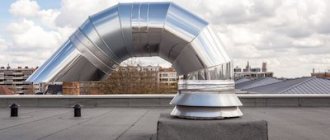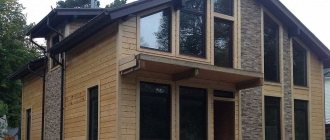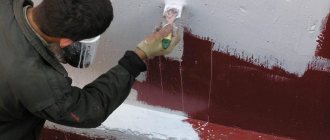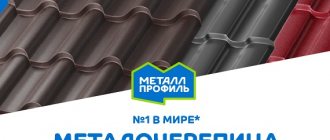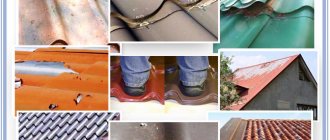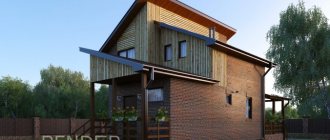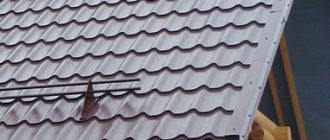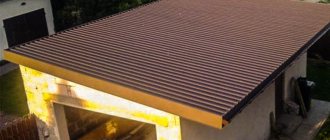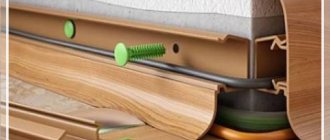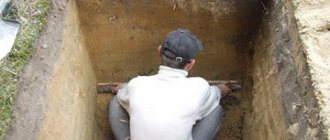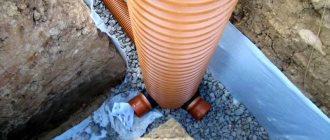A typical picture of the past from books: autumn, rain, dripping from the roof... A strange situation, isn’t it? But could it have been different if, until relatively recently, roofs were waterproofed exclusively with parchment and short-lived roofing felt. If at all they used anything other than raw wood. But today, materials for roof waterproofing are so different and in such a large number of types that it is difficult to understand them.
Should I buy a roll membrane for my own bathhouse under construction, or is it better to use a regular film, or is it even better to use something new and unusual? But now we will help you figure this out: what and for what roofs are produced today.
Why are waterproofing materials needed?
So, is it worth saying that none of the dense roofing coverings can 100% protect the space under the roof from moisture? And it's all about the joints that any material has. And also adherence to the walls, pipe outlets and much more. Take the same self-tapping screws and similar fastenings, which are quite rarely mounted completely hermetically and in accordance with all the rules.
Now let's look at the problem from the other side. In every residential building there is water vapor that comes from people's breath, a hot iron, or a pot of food. And all this, according to the laws of physics, of course, rises upward. As a result, whether there is insulation in the roofing pie or not, the steam still reaches the roofing cladding itself. This can only be saved by a good vapor barrier, but when installing a so-called cold roof, on the contrary, it is not installed. And all this, plus the natural humidity of the air above the insulation from the street side, will certainly settle in the form of condensation.
Those. In addition to moisture that comes from outside, condensation also penetrates into the under-roof space. This is a physical phenomenon that we have known since school: if the temperature regime in the closed under-roof space and outside differs significantly, then the moisture in the air settles in the form of droplets. Scientifically, this process is called the formation of a “dew point.” And only proper waterproofing and a ventilation system, which will help particles of water vapor to evaporate before condensation forms, can completely get rid of this phenomenon.
In a word, there is somewhere for moisture to get into the under-roof space. And our task is not to let it go beyond waterproofing, so that the roof itself serves us faithfully for as long as possible.
The choice of waterproofing material for the roof depends on the following parameters:
- Economical
- Practicality
- Maintainability
- Safety
- Environmental friendliness
- Toxicity
- Difficulty performing the work
The ideal option is when you install waterproofing, insulation, and vapor barrier from the same manufacturer.
The role of the waterproofing agent
Waterproof barriers in the roof structure are functionally necessary:
- prevent the coating from getting wet, which prevents deterioration of the thermal insulator properties and changes in thermal conductivity;
- protect wooden rafter beams from dampness if any damage to the finishing occurs;
- protect structures from internal condensation formed from the ingress of moist air and temperature fluctuations.
The important role of waterproofing is manifested in the following:
- ensuring the durability of the roofing structure;
- maintaining favorable humidity, reliable ventilation;
- maintaining the operational properties of the heat insulator;
- protection of wood rafter beams.
The absence of a waterproofer or poor-quality installation of a waterproof barrier negatively affects the strength of the entire roof and increases heating costs.
Waterproofing flat roofs
Separately, we note methods of waterproofing roofs that are almost flat - the angle of inclination does not exceed 5%. These are standard roofs of apartment buildings and private outbuildings. Waterproofing of such surfaces is usually carried out using self-leveling, coating, spraying and welding materials.
Welded waterproofing
The weld-on waterproofing is laid overlapping and then melted using burners. A fairly cheap way to completely protect the roof, but dealing with complex seam sealing and open flames is not the most pleasant.
Until recently, roofing felt and glassine were used as roofing insulation, the functionality and durability of which are questionable. But flammability is without a doubt. But today, roll roofing materials are used in two types: polymer and bituminous. Polymer coatings are characterized by a lower cost of coating and relative lightness.
Rolled waterproofing materials can be used on flat roofs or roofs with a slight slope. And a new modification of roofing felt, Euroroofing felt, is actively gaining popularity. This material is made from bitumen, polymer materials and synthetic rubbers. For comparison: in ordinary roofing felt the base is cardboard, but in euroroofing felt there are already synthetic fabrics, which, you must agree, is much stronger. And in order to make the euroroofing felt more durable, a multi-colored coating of mineral chips is additionally applied to it.
Spray waterproofing
Coating, pouring and spraying waterproofing materials create a complete, unbreakable membrane on the roof, with excellent qualities and practicality. But such waterproofing requires special equipment.
Powder insulation is also popular - these are mixtures based on synthetic resins, cement, plasticizers and hardeners. Such mixtures are sold in dry form, and you need to mix them at the work site.
More modern liquid waterproofing is water repellent. These are mixtures based on silicic acids, silicones and organic solvents. The main task of such waterproofing is to be absorbed into the concrete surface and thus provide complete protection against leaks. This material completely repels water, but at the same time – you will be surprised! - still breathing. The only disadvantage of such waterproofing is that after a couple of years the top layer washes away its important elements and begins to “fear” water. That is why such waterproofing is now more actively used for vertical roof surfaces of complex structure.
Coating waterproofing
Modern bitumen waterproofing of flat roofs is no less popular than more innovative solutions. Significant advantages play a role here: reliability, ductility, strength, softness and absolute resistance to temperature changes and any precipitation. Bitumen-polymer and bitumen materials for waterproofing roofs are good primarily because they create a multi-layer structure with a durable synthetic base - fiberglass or polyester fabric.
Basically, bituminous materials are divided into two main types:
- SBS-modified materials with Styrene-Butadiene-Styrene. This waterproofing perfectly withstands changing seasons and low temperatures.
- APP-modified materials with APP polymers. This waterproofing has high heat resistance.
For snowy Russia, of course, the first option is more preferable.
Special mastics - plastic waterproofing materials - are made from bitumen for waterproofing roofs. To do this, liquid bitumen is simply mixed with polymers and mineral fillers. This includes bitumen-rubber mastic, bitumen-polymer mastic, primer, and bitumen-emulsion. And these mastics are cold and hot. We recommend that you work with the first type, because... Hot materials require specialists. Not to mention the restrictions. For example, bitumen-based waterproofing materials cannot be used under metal tiles.
Mounted waterproofing
Sometimes, in special cases, even on a flat roof you have to try conventional film waterproofing:
Waterproofers for different types of roofs
A typical waterproofing of a sloping roof is carried out by applying a coating with insulation, which is protected on one side by a vapor barrier and on the other by a waterproof coating against precipitation. The waterproofing layer is usually located directly under the finishing flooring.
The influence, although weakened, of sudden temperature changes and ultraviolet rays creates loads on the under-roof pie. The correct selection of insulating agents is critical. The guaranteed service life of various coatings ranges from 10 to 50 years.
The design features of sloping roofs do not allow the use of bitumen-based water protection methods associated with heating gas burners. Waterproofing of a flat roof used to be no different from the pitched version - it was laid last, which created an increased risk of damage.
New technologies make it possible to lay a layer of waterproofing material between the primer and geotextile, which ensures complete waterproofness. Instead of the previously common bitumen resins, the latest polymer or membrane waterproofing materials are used. The service life of coatings is up to twenty years or more provided that:
- compliance with installation rules;
- using a primer to improve adhesion;
- creating a slight slope to drain sediment into the drainage system;
- performing the screed without cracks.
Requirements for the effectiveness of waterproofing materials include not only water resistance, but also elasticity, light weight, and tensile strength. Although air permeability is not considered a mandatory characteristic of a waterproofing coating, in combination with finishing there should not be a “greenhouse effect” or condensation. To eliminate negative manifestations, ventilation layers in the roof are required - between the insulator and roofing material, insulation and insulating fabric.
Waterproofing pitched roofs
When choosing a waterproofing material for the roof of your house, pay attention to how “breathable” it is. Yes, waterproofing should not let water into the under-roof space, but should it allow air? But some modern mastics and primers can completely block the flow of oxygen and disrupt the natural circulation of air in your home.
And all these modern waterproofing materials differ in frost resistance, strength, water resistance and durability.
- According to their physical condition, all waterproofing materials are usually divided into roll, powder, film, mastic and membrane.
- By method of application: pasting, cast, plastering, painting, injection, mounted, penetrating, impregnating and backfilling.
Roll waterproofing
Rolled non-woven waterproofing materials are most suitable for protecting the roofs of private buildings from moisture.
Unlike roofing felt and glassine, whose service life does not exceed 5 years, modern roofing hydromaterials last from 30 to 100 years.
Welded waterproofing
This is a modern roll membrane, which is attached to the slopes using “hot spots”.
Film waterproofing
Films, as the lightest and at the same time quite practical material, will not soon lose their popularity among roofers. There are three main groups: polyethylene films, polypropylene and modern membranes.
We'll talk about membranes later. But polyethylene roofing film is a waterproofing coating made of polyethylene fibers and reinforced with fabric or a special mesh. Often, newcomers to the construction business make the following unfortunate mistake: they believe that film waterproofing can be completely replaced with ordinary wooden flooring. Someone does this. And at this stage, many people have the following question: “So, film or wooden flooring?” In fact, we are talking about two completely different materials when constructing a roof. The main task of the film is maximum waterproofing, in simple terms, simply draining rain and melt water from the roofing pie. But wooden flooring is often made in order to create a rigid base for soft roofing material, such as bitumen shingles.
Some films also have high frost resistance. Thus, micro-perforated reinforced film from Silver 100 can completely replace roofing felt in roofing work. Moreover: unlike roofing felt, it does not stick together, and weighs much less, and also allows condensation to pass through, and now the tree will not become limp.
Prices for construction and installation of roof waterproofing
Below is a table describing the prices for installing various types of waterproofing protection. The prices indicated are preliminary and may change depending on the complexity of the object and its other parameters. To obtain an accurate calculation of the price for installation and waterproofing work, it is recommended to contact our estimate department by phone or by sending a request to our email address -
If necessary, our field engineers can go to your site, take the necessary measurements and give the necessary advice on all possible options for protecting your home or building from water.
| Name of works | Unit _ | Price in Rubles |
| Waterproofing works | ||
| Work on installation of built-up waterproofing in 1 layer horizon | m2 | from 360 |
| Installation of built-up waterproofing in 1 vertical layer | m2 | from 480 |
| Installation of PVC membrane horizon | m2 | from 580 |
| Vertical PVC membrane installation work | m2 | from 600 |
| Work on the installation of a pole weaver | m2 | from 900 |
| Work on installation of bitumen mastic | m2 | from 200 |
| Work on the installation of liquid rubber | m2 | from 300 |
| Work on the installation of polymer-cement waterproofing | m2 | from 600 |
| Work on installing polyurethane protection | m2 | from 600 |
| Applying primer or primer | m2 | from 100 |
| Installation of ebb tides | m.pog | from 400 |
| Installation of drip pipes | m.pog | from 200 |
| Installation of drain funnels | PC | from 1900 |
| Roofing | ||
| Installation of gutters | m.pog | from 400 |
| Installation of thermal insulation | m2 | from 150 |
| Slope screed device | m2 | from 600 |
| Installation of fillets during the transition from horizontal to vertical | m.pog | from 100 |
Roof waterproofing cost calculator
Click to open the calculator and calculate the cost of work
Calculation of the cost of waterproofing a roof, terrace or balcony
"Smart" membranes for roofing
Membranes are a new generation of waterproofing materials for roofs, combining many of the positive qualities of previous types.
Almost all modern membranes can be called “breathable”. This is a kind of waterproofing that completely protects the under-roof space from the penetration of atmospheric moisture, but at the same time remains almost transparent for the escape of water vapor from the inside.
Modern membranes mostly consist of non-woven synthetic fibers. Thanks to their special unique properties, it is possible to completely avoid installing a ventilation gap under the roofing cladding material. But this means saving up to 50% of space! It is much more rational to fill it with the same insulation. That is why, when converting a cold attic into a residential attic, a membrane is traditionally used as waterproofing.
Perforated membranes
Polyethylene films are also divided into perforated and non-perforated. The former are intended for waterproofing, the latter for vapor barrier.
Perforated membranes are special combined fabrics and reinforced films through which water vapor escapes through punctured holes (that’s why they are called perforated). Their vapor permeability is quite low, only up to 40 g/m2. These are intended for waterproofing cold roofs, and in an insulated roof they can only be installed with double-sided ventilation. But in frosty weather, the steam that settles on the inside of such membranes becomes drizzle and clogs all the small holes, thereby reducing the vapor permeability of the material to almost zero. The only way out is to leave the ridge open during installation so that the film does not reach the top of the rafters by 10 cm:
Porous membranes have an innovative filter structure. These are many interfiber pores through which water vapor easily passes. Over time, this waterproofing property decreases, because pores become clogged from dirty city air.
When installing warm roofs, you need to use not just a vapor-waterproofing film, but a vapor-permeable membrane:
But with one or two ventilation ducts you need to install such membranes, read their packaging - each manufacturer has its own requirements.
Universal membranes
There are also universal membranes with anti-condensation properties. One side is smooth, the other is rough, which is exposed to water vapor. But a smooth one means possible water leaks. Such membranes can be used both as internal vapor barrier and as under-roof waterproofing:
Anti-condensation membranes protect the roofing pie from both water and steam. This is the best material for euro slate and metal tiles.
Multilayer membranes
Modern roofing membranes come in one, two and three layers. Using a single-layer membrane on roofs is a mistake. This way, condensation will not be able to escape, and therefore the insulation will become damp and lose its properties. For example, mineral wool crumbles and settles when cold, thus forming new cold bridges.
Three-layer superdiffusion membranes are rightfully considered the most practical today. They are made of several layers, in which there are no longer holes, and they do not clog over time. Such membranes have 100% wind protection.
But double-layer film membranes are a cheaper version of three-layer ones. These do not have one of the protective substrates, which significantly reduces their reliability. They serve for quite a long time, but are easily torn during installation.
For example, the Delta FOXX roofing membrane already has a two-layer structure. The bottom layer is non-woven polyester, and the top layer is a dispersion water-repellent and vapor-permeable coating. This material has one of the highest vapor permeability values (Sd = 0.02 m), and non-woven polyester as a base gives more strength and elasticity. This is the kind of film that is not afraid of the sharp edges of the sheathing boards, and withstands all roofing work and workers’ feet quite well.
Diffuse or breathable membranes
As we have already said, diffuse membranes have many small holes through which steam and condensate pass. That is why they cannot be pressed too tightly against the thermal insulation - the holes will block and the membranes will simply cease to perform their functions.
Only modern super-diffuse membranes can be laid directly on a thermal insulation layer. These insulating coatings have a much higher coefficient of vapor and waterproofing, and therefore lower ventilated gaps are not important for them.
Features of choice
The installation of roof waterproofing involves taking into account many factors, including individual wishes and budgetary resources. When choosing a type of water protection, you can rely on the following:
- roof functions;
- design features;
- type of coating;
- type of insulation.
Before choosing a type of insulator for a roof, experts suggest relying on the following advice:
- among rolled sheets, roofing felt is the most accessible, but it is better to use analogues with improved properties: rubemast, euroroofing felt;
- protection of uninsulated attics is optimally formed using perforated film and insulation;
- liquid waterproofing for roofing is most effective for flat surfaces with recesses and gaps;
- membrane water protection is suitable for finishing geometrically complex roofs;
- Roofs with metal roofing materials are best reinforced with an anti-condensation membrane. Installation includes two ventilation gaps and additional installation of sheathing.
It is impossible to determine which waterproofing agent is more effective; each decision is individual, and there cannot be a definite answer. It is believed that extensive waterproofing is necessary with the lowest roof slope, since the liquid stagnates and there is a risk of leaks. With slopes of more than 35 degrees, only vulnerable areas can be strengthened. In practice, hydroprotection of the entire surface is more effective than fragmentary one, because there are fewer connecting seams.
How to order a service?
To order roof waterproofing in Moscow, just contact Gidropro managers. Stages of cooperation with Gidropro: 1. Call the organization, clarify the details of the order. 2. Visit of a specialist. 3. Inspection of the facility, calculation of the working estimate, drawing up a work project. 4. Drawing up a contract, agreeing on the time of work and payment. 5. Performing roof waterproofing. 6. Getting the result. Managers of Hydropro LLC will respond to your request in a matter of minutes. They will also help you waterproof your roof for flat, pitched and any other type of roof in the shortest possible time.
Slate and ondulin
Although these materials are different in composition, the likelihood of condensation appearing on their surface is low.
Slate is best in this regard. Its surface texture can be compared to an anti-condensation waterproofing film. A rough surface can retain condensation until conditions for its evaporation and weathering occur. Therefore, waterproofing is not needed for a cold slate roof.
An example is Soviet-built apartment buildings - most Khrushchev buildings have slate laid over lathing without waterproofing. And the only reason the attic gets wet is roof leaks.
Ondulin has almost the same properties. On the manufacturer’s website, as one of the “economy” options for installing a cold roof, a laying diagram without waterproofing is given. And this option is suitable for country houses and summer cottages, summer kitchens and outbuildings.
For permanent residences, roofing made of slate and ondulin without waterproofing is considered not reliable enough. And here it is recommended to lay waterproofing roll materials. The structure of the roofing pie is standard - the film is attached to the rafters with a slight sag, counter-lattice beams are stuffed on top and the sheathing is mounted.
There are several types of roofing material where this term is present:
Bituminous shingles. Waterproofing is provided at the level of installation technology from the manufacturer. This is a lining carpet that also serves as an additional fixing element. The bitumen contained in shingles and carpet bakes together when the roof heats up from the sun.
Composite tiles. This is a kind of metal tile with a small sheet size. The differences lie in the composition of the protective and decorative layer. As with any metal roof, waterproofing must be installed underneath it.
Ceramic and cement-sand tiles. They differ from each other in composition, shape, manufacturing technology. But despite this, installation proceeds according to general principles. And the manufacturers of these types of roofing, when describing the installation technology, also stipulate the presence of waterproofing.
Stekloizol
This type of roof waterproofing is made using a unique technology. A binder containing bitumen is applied to the base on both sides.
The outer side of the material is covered with coarse-grained topping. This creates a protective layer. The material has the following advantages:
- High moisture evaporation;
- UV resistance;
- Resistance to environmental influences;
- Resistance to mechanical damage.
It should be noted that this material can be laid at low ambient temperatures. Stekloizol will not lose its elasticity. The basis of this waterproofing material is fiberglass or frame fiberglass.
Introduction
The durability and reliability of the roof largely depends on how well the under-roof space is equipped. Waterproofing makes it possible to protect the sheathing and other roof elements from moisture. There are a huge number of offers on the market from different manufacturers. You should have a good understanding of their properties in order to choose a material that is ideal, in your case, for reliable protection of the roof from vapors, water and snow.
Performance qualities of roofing material
Due to its low price, it has become a popular material for installing cold roofs. Typically used on roofs where the slope angle ranges from zero to 25 degrees. However, due to the materials used in it, it is not durable and is not fireproof. Under the influence of solar radiation, the outer layer of bitumen is destroyed. This allows moisture to enter the inner cardboard base, causing the paper to rot. As a result ? The integrity of the roofing felt sheet is compromised and leaks begin. A modern analogue of roofing felt is euroroofing felt. Non-rotting materials are used in its base. The outer layer consists of higher quality, modified bitumen. This material is more durable, but is also capable of burning and is not environmentally friendly. Due to the higher price, the use of euroroofing felt on small roofs is not profitable.
